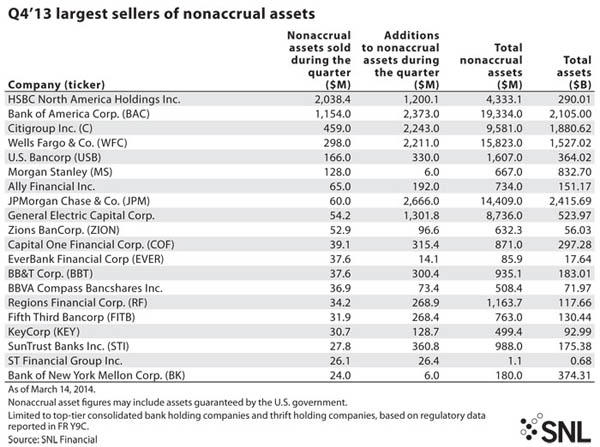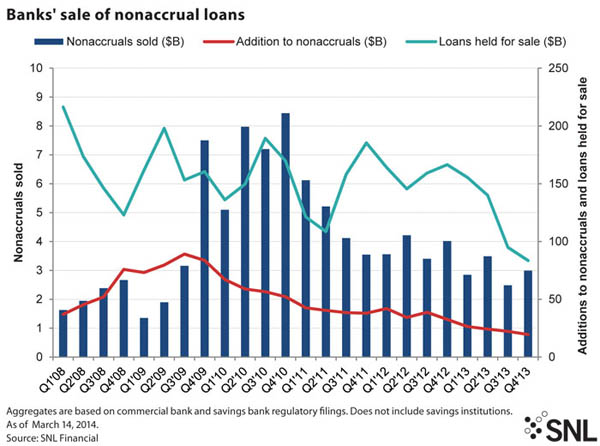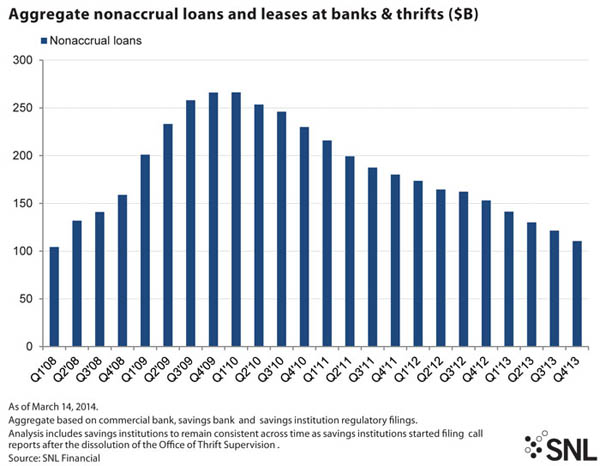Is troubled debt market done?
SNL Report: Supply dwindling, problem asset sales nearly disappeared in 2013
- |
- Written by SNL Financial

By Nathan Stovall and Salman Aleem Khan, SNL Financial staff writers
Banks' sales of nonaccrual assets petered out in 2013 as new problem loan formation slowed considerably.
Banks worked through most of their issues in years past and have long preferred workouts to large bulk sales of problem assets. Last year, and the fourth quarter in particular, proved no different as the pace of sales remained slow and declined from the pace witnessed in prior years.
The volume of commercial and savings banks' problem asset sales fell in 2013 to levels not seen since 2008. Fourth-quarter sales activity fell 25.6% from a year ago and 15.7% from two years ago.
Banks have slowed sales activity even as market conditions and pricing have increased substantially from troughs experienced in 2009 and 2010. Banks see fewer problems coming onto their books, though, with nonaccrual loans, inflows of nonaccrual loans, and provisions declining throughout the early part of 2013 and again in the fourth quarter.
Marked change in real-estate-related inventory

Real estate prices steadily improved in 2013. Through year-end 2013, home prices had risen 7.7% from a year earlier, according to the Federal Housing Finance Agency. Fewer residential properties came onto the market in 2013 as well, with the number of foreclosure filings plummeting 26% from year-ago levels.
As banks foreclosed on fewer properties, the level of other real estate owned, or OREO, on bank balance sheets declined notably in 2013. The overall level of OREO on bank balance sheets dropped 5.0% in the fourth quarter from the linked quarter and 21.3% from a year earlier, according to SNL data. By the end of 2013, OREO balances had fallen to the lowest level since the second quarter of 2009, though the workout process remains relatively slow and a sizable amount of mortgages remain in the process of foreclosure—close to 2.5x the amount of OREO on banks' books.
Still, banks have far smaller plans to sell problem assets now than they did in the past quarters, perhaps owing to better credit quality trends. Banks reported $83.47 billion in loans classified as held for sale in the fourth quarter, compared to $94.98 billion in the third quarter and $166.49 billion a year earlier, SNL data show.
Loan data looking brighter
Banks see fewer loan losses forming as well, with provisions dropping more than 50% in the fourth quarter from the linked quarter. Virtually all banks have experienced significant improvements in their credit quality, with adjusted nonaccrual loans falling to 1.24% of loans in the fourth quarter from 1.38% in the linked quarter and 1.71% a year ago, according to SNL data. In aggregate, nonaccrual loans totaled $110 billion at the end of the fourth quarter, down from $121 billion at the end of the third quarter and $153 billion a year earlier.
The amount of nonaccrual loans in the banking industry has fallen close to 60% since peaking in the first quarter of 2010, but much of that decline occurred in 2010 and the early part of 2011, when distressed asset sales activity was much higher.
SNL data show that sales activity began to reach its highest level in 2010 and peaked in the fourth quarter of that year, totaling $28.71 billion in 2010. Sales activity fell substantially in 2011, particularly in the latter half of the year when investor sentiment toward banks soured and capital raising slowed. Sales of nonaccrual loans fell to $19.00 billion in 2011, with just 40.34% of the overall sales activity coming in the last six months of the year, according to SNL data.
After a lackluster ending to 2011, nonaccrual sales remained slow in 2012, falling to $15.19 billion, or down 20% from a year earlier. Sales activity rebounded some in the fourth quarter of 2012, eclipsing the $4 billion mark for only the second time in a five-quarter period.

Nonaccrual sales activity in 2013 proved choppy, but ultimately finished the year at subdued levels. Sales activity fell below the $3 billion level in the first quarter, in the third quarter and again in the fourth quarter, totaling $2.99 billion in the last period of the year. Overall nonaccrual sales activity in 2013 fell to $11.81 billion from $15.19 billion a year earlier.
Banks sold far fewer distressed loans last year as the pace of problem loan formation declined notably in 2013, dropping 37% from the prior year. Additions to nonaccruals declined in the fourth quarter, falling to $19.53 billion from $22.22 billion in the linked quarter and $32.62 billion a year earlier.
HSBC stands out among sellers
Most banks seemed to take new problem loan formation largely in stride and did not engage in heavy selling activity in the fourth quarter. Few community and regional banks purged their balance sheets of problem loans in the fourth quarter and the nation's largest institutions were easily the most active sellers in the period.
For instance, HSBC North America Holdings Inc. made waves, selling $2.04 billion in nonaccrual assets in the fourth quarter, or roughly 1.7x the level of nonaccrual inflows it reported during the period. Although banks do not break out problem loan sales by asset type, more than 90% of HSBC North America's nonaccruals at the end of the third quarter came from closed-end first-lien one- to four-family loans. HSBC reported a sizable decline in nonaccruals tied to that loan type in the fourth quarter, disclosing that those nonaccruals fell to $3.82 billion from roughly $5.80 billion in the third quarter.
Aside from HSBC North America, most banks' selling activity was relatively small when compared to the size of their balance sheets. Most sizable, publicly traded banks, including those institutions that operate in areas that experienced severe distress during the credit crisis, have worked through the bulk of their credit problems.

Tagged under Management, Financial Trends, Credit Risk, Feature,














